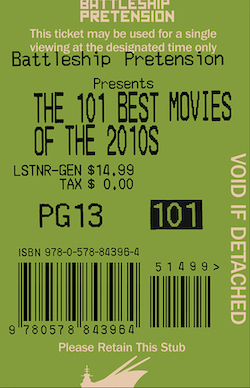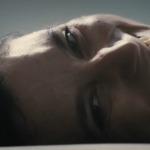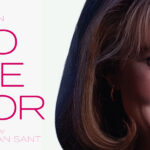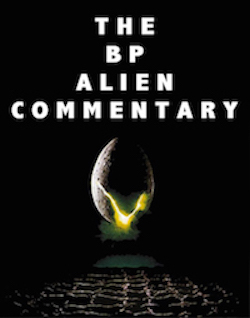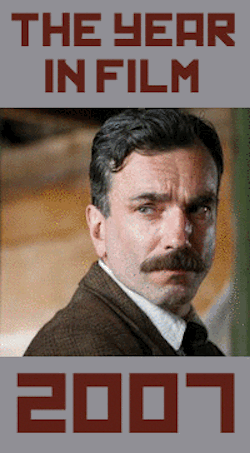Ebertfest 2015: Day Three, by Aaron Pinkston
The second full day of Ebertfest began with some bad news: somehow, the print of the day’s first film, the French coming-of-age drama Girlhood, came without subtitles. Since Ebertfest takes place in Champaign, Illinois, not Champagne, France, this wasn’t going to work. The festival directors were able to secure a screener copy of the film, an imperfect compromise. The festival prides itself on getting the best prints and digital projections possible, so seeing a blown up DVD copy, complete with an ever-present “Copy of Strand Releasing” subtitle, was a bit disappointing. Thankfully, seeing Girlhood was worth it. The rest of the day went swimmingly with the two oldest films of the festival screened.
Whether it was an easy marketing ploy or pure coincidence, Girlhood shouldn’t be thought of as a cash-grab knockoff of indie wonderfilm Boyhood. No, Girlhood didn’t film a group of actors for eight years and isn’t a timestamp for the pop culture events of the new millennium, but it is definitely worth your time. Céline Sciamma, who previously directed two other wonderful films about young people, Water Lilies and Tomboy, mixes realism with heavy dramatic stakes in an environment we aren’t used to seeing.
Girlhood reminds us that while the coming-of-age drama is a major genre, there just aren’t many about women. We all know why this is, but it’s a shame, especially considering just how good Girlhood is. I have nothing in common with Marieme (social status, race, country of origin, etc.) but that doesn’t mean I can’t connect with her on a human level. If anything, a female perspective can be even more compelling because of the specific pressures put on young woman. Girlhood addresses them without unnecessarily added dramatic stakes – it’s understated style, which avoids the worst-case-scenario, has more than enough drama.
The film follows Marieme, a teenager in the lower-class suburbs of Paris. With absent parents and an abusive older brother, Marieme is pressed to care for her two younger sisters. She falls into a gang of similarly troubled girls who bully the weak and pick fights with other factions. They have tough exteriors, but they are undoubtedly girls – their idea of a big night involves getting a hotel room, getting drunk and singing along to Rihanna songs. For the first time, Marieme has found a group of people with whom she can belong. They protect each other, fight for each other.
Usually it isn’t until we leave home and our core group of young friends that we become our true selves. The third act of Girlhood wonderfully explores this concept and could be an entire plot on its own – Marieme is taken to a new world, shifting from being a girl to becoming a woman. After finally leaving her abusive brother, she takes a job with Abou, the community’s most powerful drug dealer. Though most women who work for Abou are in prostitution, Marieme conceals her sexuality in order to sell drugs. I could have explored this new environment much more, but Girlhood shows enough to feel complete.
Girlhood is an extremely ambitious film. The actors, who were recruited from the streets where the film takes place, are natural for their roles, which further gives authenticity to a completely honest film. It doesn’t cover as much time as Boyhood and many other coming-of-age films, but it is just as expansive, especially in its character development.
Up next was one of Ebertfest’s most anticipated screenings: the silent film with live musical accompaniment from the great Alloy Orchestra. The three-piece junk band from Cambridge, Massachusetts always brings their strange mix of unusual instrumentation and deep knowledge of silent scoring. This year, they brought their original score for Rudolph Valentino’s final film The Son of the Sheik, the sequel to Valentino’s signature 1921 film.
In my very limited experience with Rudolph Valentino (I believe this is the first of his films I’ve seen), I don’t quite get the appeal. Obviously his tragic Hollywood story has helped keep his legacy alive, but the idea that he was the biggest sex symbol on the planet doesn’t seem right to me. Perhaps I’m just not the right person to judge. I don’t find him as striking as some of his contemporaries and he doesn’t have the physicality of Douglas Fairbanks or even Lon Chaney. Strangely, he spends most of The Son of the Sheik wrapped up in fancy garments that hide his actually muscular physique.
As an actor, he’s a bit bland but capable, with fewer moments of overacting than I was expecting. Probably the film’s biggest hook is that Valentino plays a dual role: reprising his famous role of The Sheik and also the title son. It’s a bit of a bold move and the film thankfully doesn’t squander the inherent weirdness. The film is at its most playful when it has both Valentinos on screen together with a little movie magic.
As for the film itself, it certainly wouldn’t touch my list of favorite from the silent era. A product of its time, The Son of the Sheik is incredibly misogynistic and a bit xenophobic. Valentino’s love interest is little more than an object that is meant to be tossed around. Beyond that, it is like the equivalent to the unsatisfying blockbusters we see today – little imagination, a cast of stock characters and little true drama. Outside of a large action setpiece at the film’s conclusion, the only real spectacle comes in elaborate costume and makeup and possibly the draw of its star.
Thank the festival gods that I was able to see the film with live score, as it was something I could focus myself on while not being connected to what was on the screen. My third experience with the Alloy Orchestra (the silent film two years ago, Blancanieves, used its theatrical soundtrack) is probably their weakest work overall, but still surprising and satisfying. From what I recall, this score was the most key heavy, with almost constant use of an organ. It also utilized drums throughout, with hand drums that kept the energy up and cymbals that evoked the exotic locale.
The Friday slate closed with a screening of Robert De Niro’s directorial debut, A Bronx Tale. Sadly, the festival wasn’t able to rope him in to visit Champaign, but we certainly weren’t stuck with producer Jon Kilik and writer-star Chazz Palminteri. I remember seeing A Bronx Tale when it would make the runs on HBO in the mid-90s, but I hadn’t watched it since, so it was definitely on my radar of most anticipated. While it’s certainly not an instant classic, it is a solid and very entertaining film that deserves the little recognition being selected for Ebertfest brings.
If you are like most of the universe and have forgotten A Bronx Tale, it is set in the 1960s and follows two polarizing relationships a teenage boys has with two powerful men in his community. The first is Calogero’s father Lorenzo, played by De Niro, a hardworking bus driver who tries to get his son to stay on the straight-and-narrow, despite obvious distractions all around him. The other is Sonny, played by the underheralded Chazz Palminteri, a mob boss with a heart of gold. Both men want the best for Calogero, but their different lifestyles and perspectives cause a great struggle in the young man.
The hook of the film is these two battling forces, and the performances portrayed by them are game. De Niro plays a bit against type, even though the blue collar family man does really suit him well. De Niro is an ordinary kind of guy, no frills and not incredibly attractive. On the other hand, the tall and stylish Sonny is brought to life by the man who wrote him for both stage and screen. Sonny is perhaps a bit too likeable for the type of character he is, but Palminteri can play both the menacing and charming really well. It makes sense that the two actors here are the director and the writer, as their performances really shine above everyone else.
Being based on a play may seem surprising given the gangster genre having more roots in the novel, where it can be more expansive with history and mythology, but A Bronx Tale’s dialogue gives it away. The film really lives in its dialogue, where the conversations are snappy, funny and full of character. Almost all of my favorite moments in the film are little anecdotes or bits of advice from one of the father figures to Calogero, whether its Lorenzo’s passionate pleas or Sonny’s “relationship test.” The types of conversations these may have vary in context and tone, but all are written with extreme care. Every character in the film is a stand-in for a bigger idea, but have more complexity than you would expect.
Unfortunately, the film isn’t as successful with the big picture concepts. As Calogero grows up by the second half of the film, race relations in the neighborhood become a bigger part of the plot. It all becomes a bit obvious and underwritten, surprising given the great detail in each of its characters. The budding romance between Calogero and Jane, a black girl he meets on his father’s bus, doesn’t really work, only feeling like it exists to create personal conflict in the tense backdrop. The film becomes a little too much Romeo & Juliet, using their tragic love as a way for Calogero to be caught between his love and his racist friends.
That said, it’s heart is in the right place. A Bronx Tale is surprisingly progressive for its genre. At times it seems to want to step out of the gangster world and into Do the Right Thing. Now it doesn’t have near as much heat or strength in its central voice, but that wouldn’t be achievable. In any case, A Bronx Tale is at its best when it can match its heart with lighthearted entertainment. With a number of vibrant characters and two strong central performances, it is there enough to be an enjoyable film that I hope doesn’t disappear amongst the titans of its genre.
My final correspondence will cover my final day at Ebertfest 2015, looking at two of the best foreign language films of the past year, Wild Tales and Ida, as well as the indie The Motel Life, starring Stephen Dorff and Emile Hirsch, before wrapping up with multiple time Ebertfest vet Ramin Bahrani’s newest film, 99 Homes.















